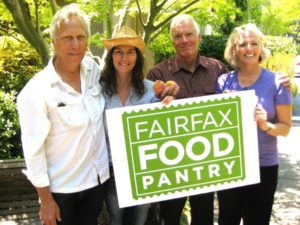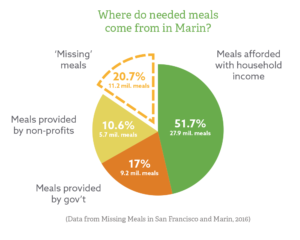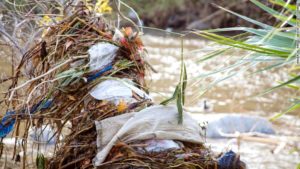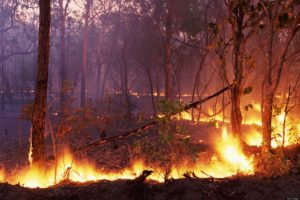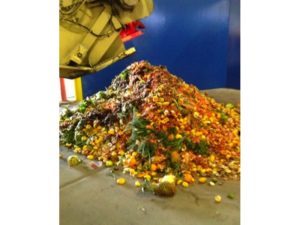By Lexi Neely, Sustainable Fairfax Intern & Drake SEA-DISK student
Paul Hawken initiated a research project that had never been done before: the goal was to find the most impactful solutions to reverse global warming based on quantifiable data. This body of work, summarized in the book Drawdown, ranks the solutions based on the amount of greenhouse gases removed from the atmosphere. Food waste comes in third place, with an estimated reduction of 70.53 gigatons of CO2 (Hawken, 2017).
The impact of food waste on the environment begins with farming itself. Conventional farming has proven to be detrimental to the environment, requiring massive clear cutting, excessive resources such as water, harmful pesticides, and fertilizers, and the extensive use of machines. Additionally, a significant amount of energy is used to run the factories and machines that process food.
Transportation of food also creates a large carbon footprint. People often purchase foods like bananas from Ecuador, rice from Cambodia, and coffee from Ethiopia without knowing how far away their foods are coming from. These items travel long distances, emitting a significant amount of greenhouse gases along the way.
Next, the food is taken to a supermarket where refrigeration coolants are used in abundance to keep the food cool and fresh. The problem with this, however, is that harmful chemicals such as hydrofluorocarbons are released which warm the atmosphere at a rate 1,000-9,000 times greater than carbon dioxide (Hawken, 2017).
There is another aspect of food waste that has proven to be very destructive to the atmosphere. Approximately 40% of food in the United States ends up in the landfill which produces extremely high amounts of methane. (USDA, 2013). The anaerobic conditions in the landfill stimulate the growth of methane producing bacteria (EPA, 2017). Methane is approximately 30 times more potent as a heat trapping gas than carbon dioxide (Princeton University, 2014).
Currently there is not sufficient data available to quantify the methane released from food waste in landfill, and therefore, it is not reflected in Hawken’s final data. But without a doubt, the number of greenhouse gases produced due to food waste is much higher than quantified in the book.
Both low-income and high-income countries have issues with food waste, however the reasons are different. In low-income countries the majority of food loss occurs primarily during production, transportation, or even in the fields. They often do not have the resources and infrastructure in place for preserving produce and keeping it fresh, and therefore it is often inedible by the time it reaches the consumer.
In higher income countries, food waste occurs closer to the retail and consumer end of the cycle. Many consumers will only purchase fruits and vegetables without blemishes, prompting restaurants and grocery stores to reject produce that is perfectly healthy to eat.
Additionally, in affluent communities, food establishments often over-order food to ensure they will have enough inventory to keep customers satisfied. People have also become less inclined to eat leftovers, which results in large percentages of food being thrown away. Most of this uneaten food travels to the landfill and produces methane gas which further perpetuates the cycle of global warming.
By reducing food waste as Paul Hawken’s book Drawdown proposes, 70.53 gigatons of CO2 could be reduced from the atmosphere (Hawken, 2017). Solutions posed in the book Drawdown give me hope that there are ways we can successfully ease and even reverse global warming.
Good News for Fairfax Residents! A small, green kitchen counter compost container was delivered to each Fairfax resident last November. Put your food scraps in the container and then dump the contents into your green curbside cart each week. You will reduce the amount of food waste in the landfills in Marin, and become part of the solution to climate change. Learn more about the program here.
Hawken, P. (2017). Drawdown: the most comprehensive plan ever proposed to reverse global warming. New York, NY: Penguin Books.
How much food waste is there in the United States and why does it matter? (2013). Retrieved November 28, 2017, from https://www.usda.gov/oce/foodwaste/faqs.htm
Princeton University. (2014, March 27). A more potent greenhouse gas than carbon dioxide, methane emissions will leap as Earth warms. Retrieved November 29, 2017, from https://www.sciencedaily.com/releases/2014/03/140327111724.htm
Basic Information about Landfill Gas. (2017, August 09). Retrieved November 29, 2017, from https://www.epa.gov/lmop/basic-information-about-landfill-gas
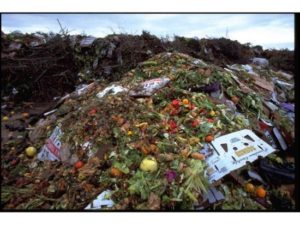
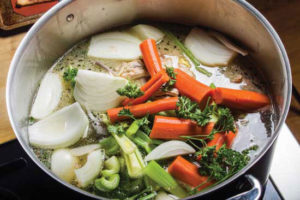
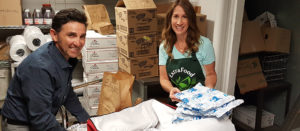 te it to someone in need. ExtraFood picks up excess fresh foods from organizations and businesses and delivers them immediately to various nonprofits that serve Marin’s population of hungry people. The foods that they deliver include fresh produce, prepared food, eggs, meat, dairy, packaged goods, and baked goods. According to Zauderer, “ExtraFood delivers food to more than 5,000 people per month to over 80 different sites around the county.” In three years of operation, ExtraFood has delivered over 900,000 pounds of food collected from over 150 donors to almost 83 different sites in Marin. This includes 13 new food programs they have started with their partners to expand the safety net further. ExtraFood has made 11,000 deliveries and continues to regularly supply food to Marin County. Zauderer explains that every donation counts, even the smallest contribution can make a difference.
te it to someone in need. ExtraFood picks up excess fresh foods from organizations and businesses and delivers them immediately to various nonprofits that serve Marin’s population of hungry people. The foods that they deliver include fresh produce, prepared food, eggs, meat, dairy, packaged goods, and baked goods. According to Zauderer, “ExtraFood delivers food to more than 5,000 people per month to over 80 different sites around the county.” In three years of operation, ExtraFood has delivered over 900,000 pounds of food collected from over 150 donors to almost 83 different sites in Marin. This includes 13 new food programs they have started with their partners to expand the safety net further. ExtraFood has made 11,000 deliveries and continues to regularly supply food to Marin County. Zauderer explains that every donation counts, even the smallest contribution can make a difference.